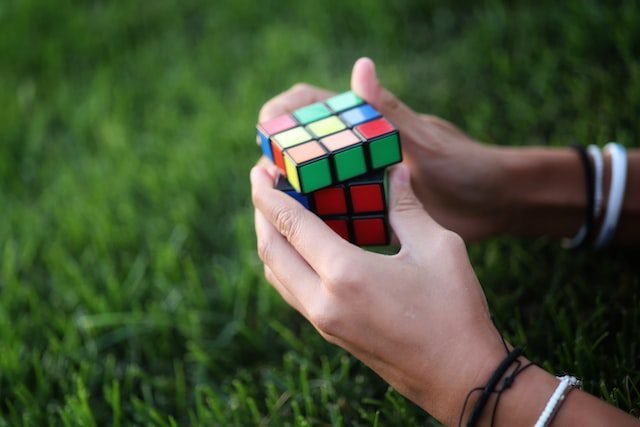Last Updated on July 11, 2024 by Asfa Rasheed
Table of Contents
Introduction
We have been a fan of the Rubik’s cube or 3×3 cube since childhood, and when we want to solve one, or just practice my speed-solving skills, we like to use this method:
Preface
So, you’re thinking about trying to solve a Rubik’s cube? Congratulations! You’ve come to the right place.
The first step in solving this puzzle is to understand what it is, how it works and what makes it so challenging.
Rubik’s cubes are made up of six faces: two red sides (or “red”), two green sides (or “green”), one white side (or “white”) and two yellow sides (or “yellow”). There are also three sets of nine small squares on each face—these can be used as part of solving the puzzle or just for decoration. There are also stickers which can be used as hints when you’re stuck on an area of your cube’s faces.[1]
How to Solve a Rubik’s Cube in 5 Steps
The Rubik’s Cube is a 3-D puzzle with six faces and 20 sides. Each face has several smaller cubes stuck to them, and the goal of the game is to get all those cubes on each side to be one color.
The cube is made up of these smaller cubes:
Front Color (top), Middle Color (bottom) and Back Color (left side), which are connected by small squares called “grips.”
Side Pieces that connect all six faces together into one solid object
Step 1: Create a Cross
Place the white side of your cube on the bottom.
Match up the colors on opposite sides of the cube by sliding them into positions that are next to each other and not touching any of the other pieces, then slide them back out again until they look right (this step may take some practice).
Match up adjacent sides by sliding their centers into their respective corners, then slide them back out again until they look right (this step may take some practice as well).
Step 2: Complete the First Two Layers
Now that you have all of the corners on the bottom face, it’s time to start orienting. Orientation is when you get rid of any remaining edges in order to finish solving your first layer. You can do this by placing one edge at a time across from one corner and rotating it so that it lines up with its corresponding side. Once an edge is oriented correctly, move on to the next one until all edges are placed in an orientation fashion for solving your first two layers.
The second half of Step 2 involves completing both layers at once (called “dual”). To achieve this, place each pair of opposite sides together into a small square shape (they won’t fit together perfectly). Then rotate them 90 degrees clockwise so that they form triangles that fit together like puzzle pieces into cubes!
Step 3: Orient the Last Layer
In this step, you will orient the last layer. This is a little bit tricky because it involves thinking about patterns and symmetry in order to figure out where to put your last layer.
The first thing you need to do is look at all of the corners on the cube. If there are any that are in an incorrect position, then use them as your guide for where you should place your last layer! For example: if one corner has been twisted or rotated, then it would be best if it was placed somewhere else on top of another corner (rather than being aligned with it). The same goes for edges that aren’t parallel or even; these should also be taken into account when placing them next to each other so they don’t get mixed up later on down below!
The last layer is the most difficult to solve, because it’s made up of the corners and edges. To solve this layer, you’ll need to use a combination of algorithms that will swap out each corner or edge in your cube.
Step 4: Permute (Swap) the Last Layer Corners
The corners are on top and bottom, while the edges are on sides; therefore switching out these two types ensures that all four sides have been permuted at least once before moving forward with solving any other part of your cube!
Step 5: Permute the Last Layer Edges
The last step to solving the Rubik’s cube is permuting the last layer edges. Permute them by using the same algorithms you used to orient corners and edge pieces, except this time you are only swapping two edges at a time instead of three. If you are still struggling with this step, try an algorithm that swaps three edges at once.
It might take some practice, but anyone can learn how to solve a Rubik’s Cube.
It might take some practice, but anyone can learn how to solve a Rubik’s Cube. It is not as hard as it looks and there are lots of tutorials online that can help you get started. There are also many ways to solve a Rubik’s Cube, so don’t feel like you have to stick with one method only.
Conclusion
In conclusion, we have seen that solving the Rubik’s Cube is possible. This can be done by following a few simple steps and keeping in mind what we have discussed here. If you are struggling with it then don’t worry, it’s not impossible! If you are now a pro in solving it , then you can try gan 11 m pro which is available on cubelelo.
Apart from this, if you are interested to know about 6 Things You Need To Know About Rubik’s Cube then visit our Gaming category.



























